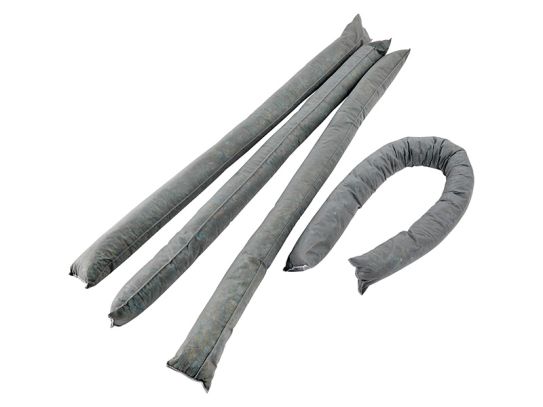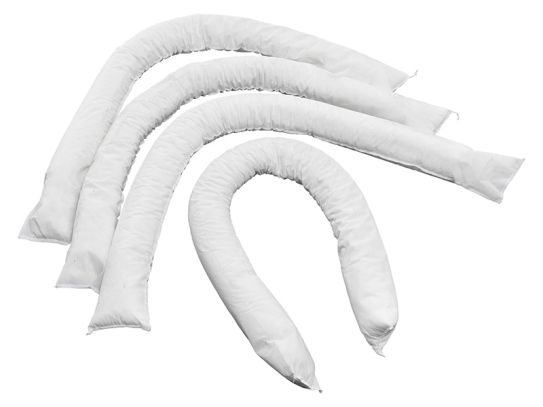Absorbent Pads & Rolls
Clean up Spills in a Snap
Don't let spills slow you down! With our quick-acting, instant relief absorbent pads and rolls, you can keep your work environment safe and clean in a snap. Whether you're dealing with oil, maintenance, or chemical spills, our range has got you covered. Keep your workspace in top condition with our top-of-the-line absorbent materials. Order now and experience the difference!
What Are Absorbent Pads & Rolls?
Absorbent pads and rolls are materials that are designed to quickly soak up liquids, such as oil, chemicals, and maintenance fluids. They are commonly used in industrial and commercial settings, such as factories, warehouses, and garages, to clean up spills and keep work areas safe and clean. Absorbent pads are typically made from materials like polypropylene or cellulose, while absorbent rolls are typically made from a perforated material that can be easily torn to size. They are used to quickly clean spills and keep a work environment safe and clean.
What Are Some Common Uses for Absorbent Pads & Rolls?
Absorbent pads and rolls are commonly used in a variety of industrial and commercial settings, such as:
- Automotive garages and repair shops - to clean up oil, grease, and other fluids that may leak from vehicles.
- Manufacturing and industrial facilities - to clean up spills of chemicals, solvents, and other hazardous materials.
- Construction sites - to clean up spills of paint, concrete, and other building materials.
- Shipping and logistics - to clean up leaks from drums and other containers during loading and unloading.
- Food Processing and Restaurant - to clean up spills of grease, oil, and other liquids in the kitchen.
- Pharmaceuticals and Medical - to clean up spills of chemicals and other hazardous materials in laboratories and medical facilities.
These are some common uses, but absorbent pads and rolls can be used in many other settings to clean up spills and keep work areas safe and clean.
What Are the Different Types of Absorbent Pads & Rolls?
There are several different types of absorbent pads and rolls, each designed to absorb specific types of liquids:
- Oil-only absorbent pads and rolls - These are specifically designed to absorb oil and hydrocarbons, while repelling water. They are commonly used in automotive and industrial settings where oil spills are likely to occur.
- Universal absorbent pads and rolls - These are designed to absorb a wide range of liquids, including oil, water, and chemicals. They are commonly used in general maintenance and cleanup applications.
- Hazardous material absorbent pads and rolls - These are specifically designed to absorb hazardous chemicals and materials, such as acids, bases, and pesticides. They are commonly used in laboratories, medical facilities and chemical manufacturing settings.
- Grease absorbent pads and rolls - These are designed to absorb grease and other heavy oils, commonly used in food processing and restaurants.
- Specialty absorbent pads and rolls - These are designed to absorb specific types of liquids such as, blood, mercury and various other types of liquids.
- Eco-friendly absorbent pads and rolls - These are made from natural fibres such as cellulose or recycled materials, they are biodegradable and non-toxic, making them a safer and more environmentally friendly option than traditional absorbent products.
The type of absorbent pads or rolls you choose will depend on the types of spills you are most likely to encounter in your specific work environment.
What Are the Key Features to Consider When Choosing Absorbent Pads & Rolls?
When choosing absorbent pads and rolls, there are several key features to consider:
- Absorbency: The most important feature of absorbent pads and rolls is their ability to absorb liquids quickly and effectively. You should look for products with a high absorbency rate, and that can absorb a wide range of liquids.
- Size and shape: Absorbent pads and rolls come in various sizes and shapes, so you should choose a size that will work well in your specific work environment. Consider factors such as the size and location of spills, as well as the space available for storage.
- Material: Absorbent pads and rolls are made from different materials, such as polypropylene, cellulose, and perforated polypropylene. Each material has its own set of properties, so you should choose a material that is best suited for the types of spills you are most likely to encounter.
- Durability: Consider the durability of the absorbent pads and rolls, as this will affect how often you need to replace them. Look for products that are made from strong, durable materials that can withstand heavy use.
- Environmentally friendly: Some absorbent pads and rolls are made from eco-friendly materials and are biodegradable and non-toxic, so it's better for the environment.
- Cost: Consider the cost of the absorbent pads and rolls, and choose products that offer the best value for money.
By considering these key features, you can choose the best absorbent pads and rolls for your specific work environment and needs.
What Are the Most Effective Types of Absorbents for Different Types of Spills?
The most effective type of absorbent pad or roll for a specific type of spill will depend on the type of liquid that has been spilled. Here are a few examples:
- Oil-only absorbent pads and rolls are specifically designed to absorb oil and hydrocarbons, while repelling water. They are commonly used in automotive and industrial settings where oil spills are likely to occur.
- Universal absorbent pads and rolls are designed to absorb a wide range of liquids, including oil, water, and chemicals. They are commonly used in general maintenance and cleanup applications.
- Hazardous material absorbent pads and rolls are specifically designed to absorb hazardous chemicals and materials, such as acids, bases, and pesticides. They are commonly used in laboratories, medical facilities and chemical manufacturing settings.
- Grease absorbent pads and rolls are designed to absorb grease and other heavy oils, commonly used in food processing and restaurants.
- Specialty absorbent pads and rolls are designed to absorb specific types of liquids such as blood, mercury and various other types of liquids.
It's important to note that when dealing with hazardous or unknown spills, you should always follow the proper protocols and guidelines for handling the spilled materials. It is also important to use the appropriate personal protective equipment (PPE) when dealing with hazardous liquids.
Are There Any Safety Precautions to Take When Using Absorbent Pads and Rolls?
Yes, there are several safety precautions to take when using absorbent pads and rolls:
- Always read and follow the manufacturer's instructions for use.
- When dealing with hazardous or unknown spills, always follow the proper protocols and guidelines for handling the spilled materials.
- Use the appropriate personal protective equipment (PPE), such as gloves, goggles, and respirators, when dealing with hazardous liquids.
- Keep absorbent pads and rolls in a safe, easily accessible location for quick response to spills.
- Properly mark and label absorbent pads and rolls to indicate the type of liquid they are designed to absorb, to avoid confusion and misuse.
- Dispose of used absorbent pads and rolls according to local, state, and federal regulations to ensure that they are disposed of safely and properly.
- Avoid using absorbent pads and rolls that have been damaged or torn, as they may not be effective and can release the absorbed liquid.
- Avoid using absorbent pads and rolls near open flame or other sources of ignition, as they may absorb flammable liquids.
By following these safety precautions, you can help ensure that absorbent pads and rolls are used safely and effectively to clean up spills and keep work areas safe and clean.
Are There Any UK or European Industry Standards or Regulations That Apply to Absorbent Pads & Rolls?
Yes, there are several UK and European industry standards and regulations that apply to absorbent pads and rolls:
- In the United Kingdom, absorbent pads and rolls are classified as a controlled waste under the Environmental Protection Act 1990. They must be stored, handled and disposed of in accordance with the regulations set out in the act.
- In the European Union, absorbent pads and rolls fall under the Classification, Labelling and Packaging (CLP) Regulation. This regulation requires that products are classified and labelled in accordance with their hazards and that the correct labelling and packaging is used.
- The European Chemicals Agency (ECHA) has also established the REACH (Registration, Evaluation, Authorisation and Restriction of Chemicals) regulations, which applies to absorbent pads and rolls that contain certain chemicals.
- The Occupational Safety and Health Administration (OSHA) in the United Kingdom also sets regulations for the safe handling and disposal of absorbent pads and rolls to protect workers' health and safety.
- The Health and Safety Executive (HSE) in the UK also sets regulations for the safe handling and disposal of absorbent pads and rolls to protect workers' health and safety.
It's important to ensure that the absorbent pads and rolls you use comply with the relevant regulations and standards in your country, to ensure that they are safe and effective to use and properly disposed of.

